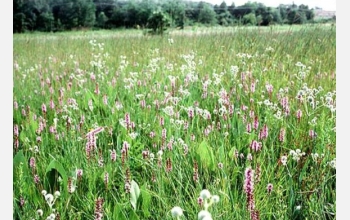News Release 06-017
For Plants, Size Doesn't Matter When it Comes to Metabolism
New calculations can aid climate models

Scientists conducted research at NSF's Cedar Creek LTER site in Minnesota.
January 26, 2006
This material is available primarily for archival purposes. Telephone numbers or other contact information may be out of date; please see current contact information at media contacts.
Scientists have found a universal rule that regulates the metabolism of plants of all kinds and sizes, and that may also offer a key to calculating their carbon dioxide emissions. That number must be known precisely to construct valid models of global carbon dioxide cycling.
In a report published in the Jan. 26 issue of the journal Nature, biologist Peter Reich of the University of Minnesota and his colleagues found that the rate of plant metabolism, or respiration--and its related emissions of carbon dioxide--can be deduced from the nitrogen content of any plant.
Plants carry out respiration during the dark hours when they, like animals, take in oxygen and give off carbon dioxide. During daylight, plants carry out photosynthesis, in which the process is reversed.
Researchers have estimated that plant respiration releases five to 10 times as much carbon dioxide as fossil fuel burning. It's crucial, they say, to know the amount of plant emissions more accurately. Yet, "the amount of carbon dioxide given off by plants is one of the weak spots in models of global carbon cycling," Reich said. The research was conducted at the National Science Foundation (NSF)'s Cedar Creek Long-Term Ecological Research (LTER) site in Minnesota, one of 26 such NSF LTER sites.
Theory has held that the rate of metabolism in plants, also as in animals, is higher in smaller plants and lower in larger ones. So to calculate how much metabolic byproduct the plants were giving off, researchers had to adjust their numbers to account for the plants' size.
But when Reich studied 500 plants in 43 species, he found that a plant's weight and its respiration rate are directly related: the heavier the plant, the more it respired. The key to metabolism rate, he found, was the element nitrogen. The more nitrogen a plant contained, the more it respired, and the more carbon dioxide the plant emitted. And, plants containing the same amount of nitrogen respired the same, regardless of their sizes.
"In revealing nitrogen content as the key to plant metabolic rates, the work uncovered a fundamental difference between plants and animals," said Martyn Caldwell, program director in NSF's Division of Environmental Biology. "Linking plant metabolism to nitrogen can also assist efforts to measure the global carbon cycle."
"If all the carbon dioxide emitted from fossil fuel burning were to stay in the atmosphere, its rate of accumulation in the atmosphere would be two-and-a-half times faster than it actually is, and climate would change two-and-a-half times faster," said Reich. "Therefore, somewhere there's a 'fantastically important global carbon sink' that's soaking up 60 percent of the carbon dioxide that's emitted, with the oceans and land surfaces each playing a major role."
Co-authors of the paper are Mark Tjoelker of Texas A&M University, Jose-Luis Machado of Swarthmore College and Jacek Oleksyn of the Polish Academy of Sciences. The research was supported by the National Science Foundation and the Wilderness Research Foundation.
-NSF-
Media Contacts
Cheryl Dybas, NSF, (703) 292-7734, email: cdybas@nsf.gov
The U.S. National Science Foundation propels the nation forward by advancing fundamental research in all fields of science and engineering. NSF supports research and people by providing facilities, instruments and funding to support their ingenuity and sustain the U.S. as a global leader in research and innovation. With a fiscal year 2023 budget of $9.5 billion, NSF funds reach all 50 states through grants to nearly 2,000 colleges, universities and institutions. Each year, NSF receives more than 40,000 competitive proposals and makes about 11,000 new awards. Those awards include support for cooperative research with industry, Arctic and Antarctic research and operations, and U.S. participation in international scientific efforts.
Connect with us online
NSF website: nsf.gov
NSF News: nsf.gov/news
For News Media: nsf.gov/news/newsroom
Statistics: nsf.gov/statistics/
Awards database: nsf.gov/awardsearch/
Follow us on social
Twitter: twitter.com/NSF
Facebook: facebook.com/US.NSF
Instagram: instagram.com/nsfgov


